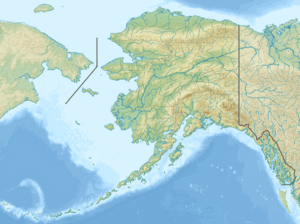Kavik River facts for kids
Quick facts for kids Kavik River |
|
|---|---|
| Country | United States |
| State | Alaska |
| Region | North Slope |
| Physical characteristics | |
| Main source | 69°08′27″N 146°18′17″W / 69.14083°N 146.30472°W |
| River mouth | Shaviovik River 70°02′43″N 147°19′47″W / 70.04528°N 147.32972°W |
| Length | 80 miles |
The Kavik River is an 80-mile-long river located in the North Slope region of Alaska. It flows very quickly and is known as a braided river. This means it splits into many smaller channels that weave together, looking a bit like a braid.
In winter, parts of the Kavik River, and the nearby Canning River, get covered with huge sheets of ice. These ice sheets are called aufeis.
River's Path and Name
The Kavik River flows towards the northwest for 80 miles (about 129 kilometers). It eventually joins another river called the Shaviovik River. This meeting point is about 28 miles (45 kilometers) southwest of Flaxman Island.
The river was given its name in 1947. A scientist named Georg Gryc from the United States Geological Survey named it. He chose the name from the Inupiaq language word for "wolverine". This was because many wolverines were seen in the area at that time.
The Kavik River Valley
The Kavik River flows through a wide, flat valley. This valley is filled with materials like sand and gravel that the river has carried over time. Along the sides of the valley, you can see different levels of flat areas, like steps, called terraces.
Sometimes, if plants are removed from the ground by human activity, the soil can wash away. This is called erosion, and it can leave scars on the landscape.
Wildlife in the Valley
The Kavik River valley is an important home for many animals. It is especially known for supporting populations of moose and musk oxen during the winter months.
Scientists first noticed these animals living in the Kavik River valley in the 1970s. This was during a study to see how building a natural gas pipeline across government land might affect the environment.
Recent Earthquake
On August 12, 2018, a large earthquake shook the area around the Kavik River. The center of the earthquake was about 42 miles (68 kilometers) east of a place called Kavik River Camp.
This earthquake was very strong, measuring 6.4 on the magnitude scale. It was the biggest earthquake ever recorded in that region.


